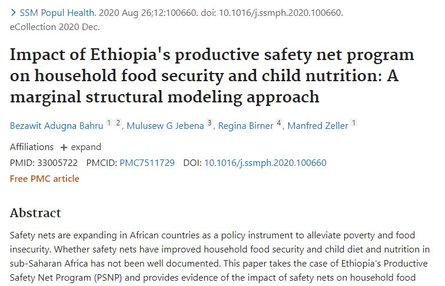
Safety nets are expanding in African countries as a policy instrument to alleviate poverty and food insecurity. Whether safety nets have improved household food security and child diet and nutrition in sub-Saharan Africa has not been well documented. This paper takes the case of Ethiopia's Productive Safety Net Program (PSNP) and provides evidence of the impact of safety nets on household food security and child nutritional outcomes. Prior studies provide inconclusive evidence as to whether PSNP has improved household food security and child nutrition. These studies used analytical approaches that correct for selection bias but have overlooked the effect of time-varying confounders that might have resulted in biased estimation. Given that household food security status is both the criteria for participation and one of the desirable outcomes of the program, estimating the causal impact of PSNP on household food security and child nutrition is prone to endogeneity due to selection bias and time-varying confounders. Therefore, the objectives of this paper are (1) to examine the impacts of PSNP on household food security, child meal frequency, child diet diversity, and child anthropometry using marginal structural modeling approach that takes into account both selection bias and time-varying confounders and (2) to shed some light on policy and programmatic implications. Results show that PSNP has not improved household food insecurity, child dietary diversity, and child anthropometry despite its positive impact on child meal frequency. Household participation in PSNP brought a 0.308 unit gain on child meal frequency. Given the consequence of food insecurity and child undernutrition on physical and mental development, intergenerational cycle of poverty, and human capital formation, the program would benefit if it is tailored to nutrition-specific and nutrition-sensitive interventions.
